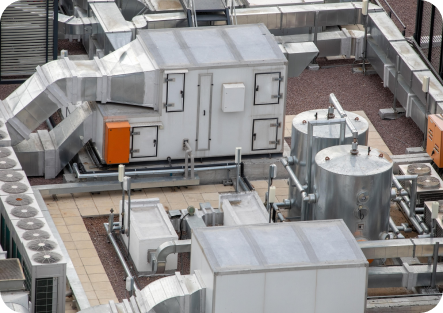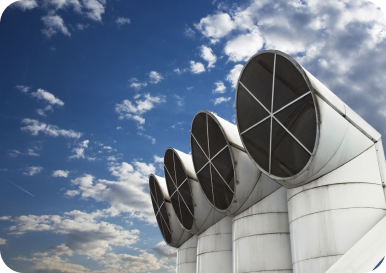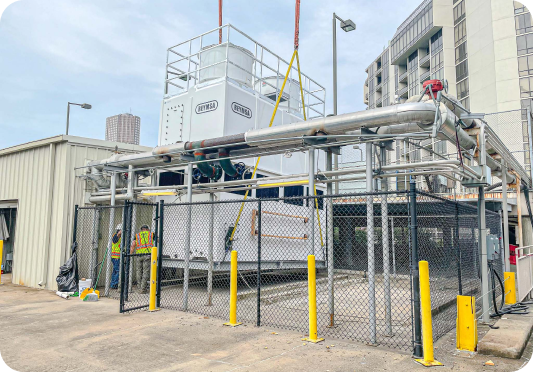The Role of Energy Efficiency in Commercial HVAC Systems
Introduction
In a world increasingly focused on sustainability and cost efficiency, energy efficiency has emerged as a crucial factor in managing commercial spaces. Commercial HVAC (heating, ventilation, and air conditioning) systems, responsible for nearly 40% of energy use in buildings, present significant opportunities for improvement.
Investing in energy-efficient technologies such as Variable Refrigerant Volume (VRV) systems and Forced Air Units (FAU), or implementing a retrofit HVAC system, can help businesses reduce operational costs while enhancing indoor comfort and sustainability. This article explores how energy efficiency transforms commercial HVAC systems, the role of cutting-edge technologies, and actionable steps to upgrade your building’s HVAC performance.

Why Energy Efficiency Matters in Commercial HVAC Systems
Energy efficiency in commercial HVAC systems directly impacts operational costs, environmental responsibility, and overall building performance. As energy costs rise and stricter environmental regulations emerge, businesses are increasingly compelled to adopt greener technologies.
Key Benefits of Energy Efficiency in HVAC Systems
- Lower Operating Costs: Energy-efficient HVAC systems consume less electricity, leading to significant cost savings over time.
- Environmental Impact: By reducing energy use, businesses lower greenhouse gas emissions and align with global sustainability initiatives.
- Improved Comfort: Modern HVAC systems provide consistent temperature control, enhanced air quality, and quieter operation, creating better environments for occupants.
- Regulatory Compliance: Governments and industry organizations offer incentives for energy-efficient upgrades, reducing upfront costs and encouraging adoption.

Investing in energy-efficient HVAC systems isn’t just a financial decision; it’s a long-term commitment to sustainability and improved building performance.
Key Technologies in Energy-Efficient HVAC Systems
What is FAU in HVAC?
The Forced Air Unit (FAU) is a staple in many commercial HVAC systems. FAUs distribute conditioned air through ducts to maintain desired indoor temperatures. Recent advancements have made FAUs more energy-efficient and environmentally friendly.
Benefits of FAU in HVAC systems include:
- Energy Savings: Modern FAUs use variable-speed motors that optimize airflow based on demand, reducing unnecessary energy use.
- Improved Air Quality: Advanced filtration systems integrated into FAUs help remove allergens, dust, and other pollutants.
- Ease of Integration: FAUs can often be retrofitted into existing ductwork, minimizing installation costs.
What is VRV in HVAC?
Variable Refrigerant Volume (VRV) systems are synonymous with cutting-edge energy efficiency and flexibility. Unlike traditional HVAC systems that operate at full capacity regardless of demand, VRV systems adjust refrigerant flow to meet specific cooling or heating requirements in different zones.
Why Choose VRV in HVAC?
- Zoned Comfort: VRV systems allow independent temperature control for multiple zones, ensuring personalized comfort.
- Energy Efficiency: These systems operate only where needed, preventing energy waste and reducing utility bills.
- Scalability: VRV systems are suitable for a wide range of commercial applications, from small offices to large complexes.
- Quiet Operation: With advanced soundproofing, VRV systems are ideal for environments where noise is a concern.
Retrofitting Commercial HVAC
The Importance of Retrofitting in Commercial HVAC
What is a Retrofit HVAC System?
A retrofit HVAC system involves upgrading or replacing specific components of an existing system to improve energy efficiency and performance. Retrofitting often includes installing modern control systems, upgrading compressors, or replacing outdated fans and motors with energy-efficient alternatives.
Advantages of Retrofitting HVAC Systems
Cost-Effectiveness:
Retrofitting is typically less expensive than installing a new system while delivering similar performance improvements.
Enhanced Energy Efficiency:
Minimal Disruption:
Extended System Life:
Steps to Achieve Energy Efficiency
Steps to Achieve Energy Efficiency in HVAC Systems
Transitioning to energy-efficient HVAC systems requires careful planning and execution. Here’s a step-by-step guide to help you get started:
Assess Current System Performance
Evaluate Retrofitting Options
Determine if retrofitting is a viable solution for your building. Retrofitting may include upgrading compressors, installing variable-speed motors, or enhancing system controls to optimize performance.
Choose the Right Technology
-
Selecting the appropriate technology is crucial. For instance:
- FAUs are cost-effective and suitable for smaller commercial spaces.
- VRV systems offer high efficiency and flexibility for larger or more complex buildings.
Partner with HVAC Experts
Working with experienced professionals ensures a smooth transition to energy-efficient systems. From initial consultation to installation and maintenance, Advanced Air Systems provides end-to-end solutions tailored to your needs.
Comparative Analysis of HVAC Solutions
When deciding on the most suitable HVAC solution for your commercial building, understanding the differences between traditional systems and advanced technologies like FAU (Forced Air Unit) and VRV (Variable Refrigerant Volume) is essential. Here’s an overview to guide your decision-making process:
Traditional HVAC Systems
Traditional HVAC systems are a common choice for smaller budgets and straightforward applications. However, they often lack the flexibility and efficiency required for modern commercial spaces. These systems tend to operate at fixed speeds, leading to higher energy consumption and inconsistent comfort levels. Additionally, they may require frequent maintenance, increasing long-term costs.
Forced Air Units (FAU)
FAUs strike a balance between efficiency and cost. These systems distribute conditioned air through ducts, providing consistent airflow and temperature control. Modern FAUs come equipped with advanced features like variable-speed motors, which adapt to the building’s heating and cooling demands, significantly reducing energy waste. FAUs are ideal for smaller to mid-sized commercial spaces seeking cost-effective solutions that improve indoor air quality and comfort.
Variable Refrigerant Volume (VRV) Systems
For larger or more complex commercial spaces, VRV systems stand out as the premium choice. These systems offer unparalleled energy efficiency by adjusting refrigerant flow based on the specific needs of each zone. This zoning capability ensures precise temperature control while minimizing energy usage. VRV systems are also known for their quiet operation, making them ideal for environments where noise control is essential. Although the initial investment may be higher, the long-term savings in energy costs and maintenance make VRV systems a worthwhile investment for businesses prioritizing efficiency and sustainability.
Benefits of Energy-Efficient HVAC Systems
Energy-efficient HVAC systems deliver numerous advantages that go beyond cost savings:
Lower Energy Bills:
Reduced energy consumption translates directly into financial savings.
Improved Comfort:
Environmental Responsibility:
Increased Property Value:
Regulatory Compliance:

Conclusion
Partnering with a trusted expert like Advanced Air Systems ensures a seamless transition to energy-efficient HVAC systems. From conducting energy audits to installing cutting-edge technology, we provide solutions tailored to your unique needs.
Contact Us
Contact Advanced Air Systems Today
Contact us today to learn how we can help transform your commercial HVAC system into a model of energy efficiency and performance.
